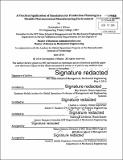A practical application of simulation for production planning in a flexible pharmaceutical manufacturing environment
Author(s)
Wilson, Christopher J. (Christopher James)
DownloadFull printable version (4.844Mb)
Other Contributors
Leaders for Global Operations Program.
Advisor
Roy Welsch and Charles L. Cooney.
Terms of use
Metadata
Show full item recordAbstract
In pursuit of Novartis Pharmaceutical's vision to "Make Quality Medicine-On Time, Every Time" Novartis Ringaskiddy Limited (NRL), is pursuing Class A Manufacturing (MRP II) certification. Achieving Class A certification requires production plans be established and met with great accuracy. The Multi Synthesis Production Unit (MSPU) at NRL sets rolling eighteen month production commitments on a semi-annual basis. During planning a rudimentary tool is used to allocate production campaigns for over 40 different Active Pharmaceutical Ingredients (API) and intermediate products across roughly 200 pieces of equipment. This manual tool is time intensive to operate, prone to errors, and requires extensive knowledge of the facility. To address this problem, a simulation based model was developed using the software package, SchedulePro". The aim of this project was to create a system to support more effective and reliable production planning. The approach requires accuracy in modeling, a process to deploy the tool and a connection to people who use and benefit from the process. In order to evaluate the proposed model and understand potential benefits to Novartis, five case studies are used to compare the proposed planning process with traditional methods. First, when planning a future production year the proposed planning process demonstrates a reduction in required time as well as an increase in accuracy. Second, when evaluating the response to a change in demand a user with little knowledge of the plant can attain comparable response time as an experienced user of traditional methods. Third, when faced with an unplanned equipment failure the user is able to explore alternative production plans which minimize disturbance to the established production plan. Fourth, through the evaluation of alternative resource allocation plans the user can determine the lowest cost approach. Finally, when applied to a product launch evaluation the model is shown to reduce the number of planning cycles, focusing specifically on the ability of the site to support a product launch in a previously allocated year.
Description
Thesis: M.B.A., Massachusetts Institute of Technology, Sloan School of Management, 2014. In conjunction with the Leaders for Global Operations Program at MIT. Thesis: S.M., Massachusetts Institute of Technology, Department of Mechanical Engineering, 2014. In conjunction with the Leaders for Global Operations Program at MIT. Cataloged from PDF version of thesis. Includes bibliographical references (pages 55-56).
Date issued
2014Department
Leaders for Global Operations Program at MIT; Massachusetts Institute of Technology. Department of Mechanical Engineering; Sloan School of ManagementPublisher
Massachusetts Institute of Technology
Keywords
Sloan School of Management., Mechanical Engineering., Leaders for Global Operations Program.